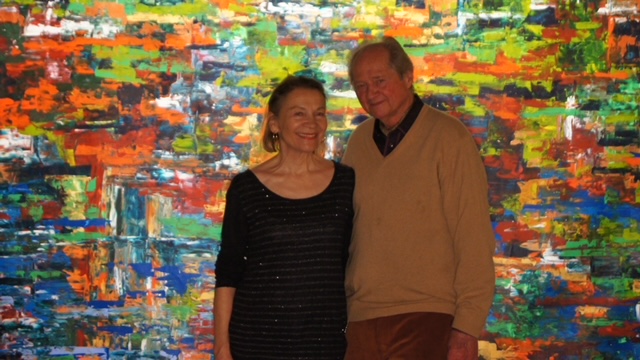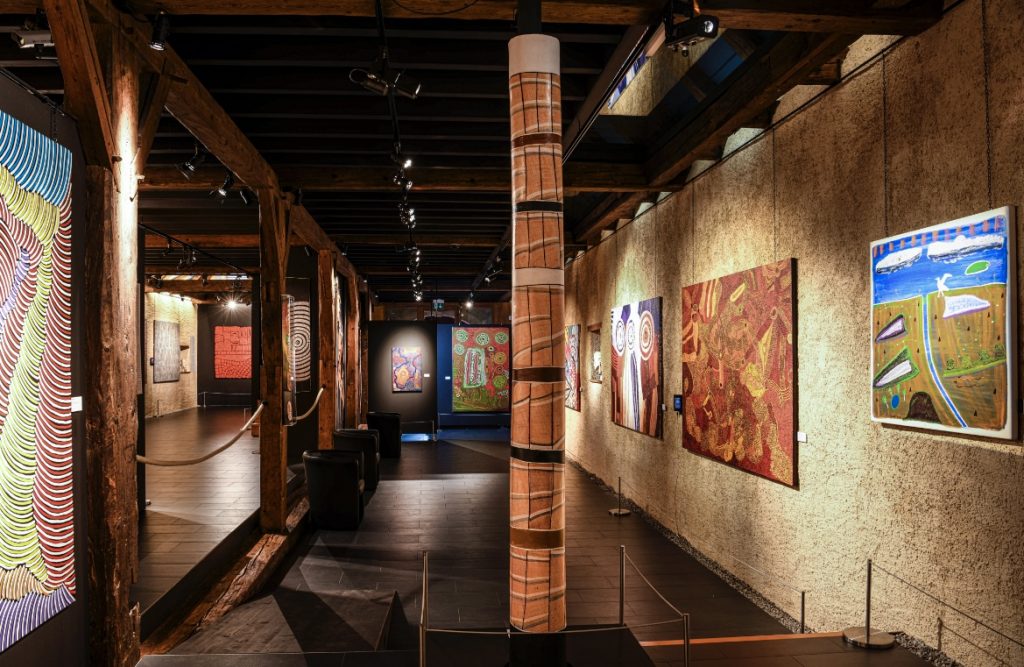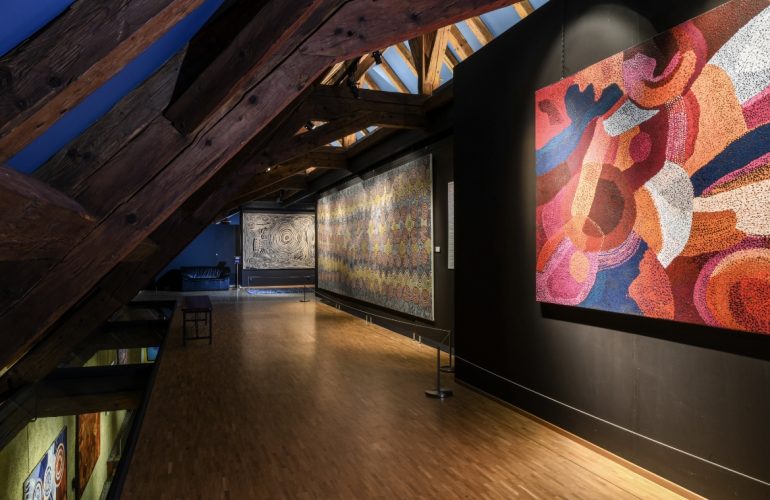This article is contributed to ArtDecision by Theresa Burkhardt-Felder.
Theresa Burkhardt- Felder and her husband are the founders of the Foundation Burkhardt-Felder Arts and Culture and run an Australian Aboriginal Art Museum in Môtiers, Switzerland:

Why and since when do we have this passion for Australian Aboriginal art?
Once we had established ourselves in Australia in the 1980s, we wanted to know more about the first inhabitants of our new country … and we discovered a fascinating, ancient culture, approximately 60,000 years old. At about the same time, an Australian artist friend showed us his latest acquisition, an Aboriginal artwork on bark, and we were very much taken with it. We became aware that we were witnessing the world’s oldest continuous artistic tradition and could not resist its almost hypnotic power. We slowly started to collect and have been doing so ever since.
About Aboriginal culture and art:
I think that in order to better understand Aboriginal art, we must go back to what Aborigines call Dreamtime and Dreaming. They believe that mythical Ancestor Beings, also called Dreaming Ancestors, came down from the sky and arose from the sea and the earth. They created the land, the fauna and flora, the human beings, the waterholes, the rivers and mountain ranges. They shaped the earth and fashioned the landscape into its current form. They also instituted the Sacred Law. Once accomplished all this, they did not leave the earth but transformed themselves into elements of the landscape. For the Aborigines, their mythical Creator Ancestors continue to be present on the sites they marked and named.

Does it all go back to Dreamtime?
It is more complex than that. Dreamtime does not only refer to the time of creation but is actually of continuous permanence. It encompasses the past, present and future. It is a holistic concept.
What is Dreaming?
Dreaming might be an animal such as a kangaroo or an emu, an insect, a type of flora, a type of bush food, a human Ancestor, a part of the environment like water, dunes, rockholes or stars. Each Dreaming has an accompanying narrative which can be sung, told as a lengthy story, danced or painted. Themes in Aboriginal art are mostly based on the knowledge transmitted by Ancestor Creators through Dreaming narratives.
What have Aborigines been painting?
Since Aborigines did not know handwriting in our sense, they transmitted their ancient knowledge through artistic means. During their ceremonies, they practised body painting or drew symbols into the sand. The effect was rather ephemeral, except for rock art of course, and access to ceremonies was restricted to initiated Aborigines. In the 1970s, in the depths of the Australian desert, in Papunya to be exact, Elders decided that the time had come to share their culture with the rest of the world.
It is important to know that under indigenous Law, an artist is not permitted to paint the Dreaming of another person or group. It is of course the artist’s privilege how to paint their Dreaming. Some opt for an aerial view of their country, others depict ceremonial sites, show aspects of body painting, medicinal plants, the journeys of their Creator Ancestors, or aspects that refer to their totem animal. In the desert, they use little if any figurative art so their artwork suggests a sacred abstraction.
What are the materials they paint with?
Originally, they painted with ochre, found on their ancestral lands, which they would mix with other natural pigments. Their surface was bark and wood. But when given the availability of modern materials such as acrylic colours and canvasses, an entire new movement of contemporary art developed. One of the greatest artists is the Grand Old Lady, Emily Kame Kngwarreye – she commenced painting when well into her seventies – who started using acrylic colours in a novel, luminous way. Her works reveal vibrancy and describe a deep connection with her tribal land. When asked, what her paintings showed, she would just answer: “My country, my country. “
In some regions, like in the North of Western Australia, Aboriginal artists still like to use ochre. They collect it from specific sites on their country, which speaks for the nature of their relationship to the land. In our collection, we also have the distinguished artist Rover Thomas who condensed in his paintings mythological and topographical information into simple abstract elements by means of ochre on canvas or earlier on also on wood.
In other areas again, like the Arnhem Land, they continue to paint on Eucalyptus bark with natural pigments.
Common to all artists – from the Kimberley and the Arnhem Land, from the coastal areas and the desert as well as from the cities – is this almost palpable love and respect that they have for their country.
What do Aboriginal people want to tell us with their art?
Their creations demonstrate what is most important to them and what constitutes their identity. To them, the different forms of landscape symbolize the materialization of the Ancestral Beings who gave them the codes and rules for social life. Their mythical presence bestows a sacred aura to the traditional territories. This is also celebrated in ceremonial activity. To claim lost ancestral territories, Aboriginal artists successfully used their paintings in court to prove their ownership of land. Consequently, it enabled many Aboriginal groups to return to live on their ancestral lands. Art for Aboriginal communities is therefore also an instrument of struggle for the cultural and political recognition of a population that has suffered greatly since colonization. Art has enabled community development and has given them an increased collective self-esteem. As an artist told me “Now the world knows that we, too, have a culture.”
About the Aboriginal people:
They were semi-nomads, living within the boundaries of their ancestral land. There are many different Indigenous groups, each with their own language or dialect. It is estimated that before European settlement, there were over two hundred and fifty languages and between six hundred to eight hundred dialects. Many languages have since become lost. Aboriginal population accounts for about 4 % of the total population in Australia, which is the size of 186 times the size of Switzerland or 14 times that of France.
Museum in Switzerland:
When we came back to Switzerland, we felt an increased desire to share this unique artistic tradition with the public. We integrated our collection into the Burkhardt-Felder Foundation and restored a 300-year-old building to house it. Our Aboriginal Art Museum, the first of its kind in Switzerland, opened in 2008 and has staged different exhibitions since, with themes like “Treasures of the Spirit” to put emphasis on the spiritual aspects of this art… or “Aboriginal Visions” to demonstrate how the artist’s eye adjusts to specific environments … or “Sky and Desert” which reveals their knowledge of sacred landmarks, waterholes, celestial occurrences. The current exhibition is like a pictorial journey across Aboriginal Australia. It shows powerful works impregnated with ancient wisdom, created by well-known artists. We shall continue in this way.
What resonates with the public?
Most visitors are touched by the power and strength that emanate from the artworks. There is admiration for the richness and complexity shown. They are impressed with the diversity of styles and the vibrancy of colours. Personally, I am very sensitive to artworks carried out by elders who up to adulthood had led a very traditional life. They exert a magnetic power. We also continue to collect the works of the younger generation. There are some wonderful young artists who surprise us with their sophisticated paintings while adhering to their culture. I would like to say…in Australian Aboriginal art, spirituality seems to rhyme with beauty.

October 2022
Front image: Musée “La grange”, 2nd floor, © Fondation Burkhardt-Felder

